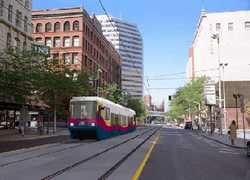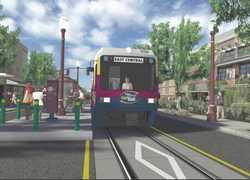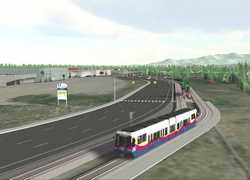
 The "Vision"
The "Vision"
The Original Study
Following the advisory vote in 2006, members of the Light Rail Steering Committee felt that the overall vision for light rail transit (LRT) had not been adequately conveyed to the overall public. While the committee members envisioned a truly regional system, much of the outreach focused too heavily on the initial proposal for light rail running from Spokane to Liberty Lake through Spokane Valley. This was considered the most viable option for the first segment of what was to eventually extend from Cheney to Coeur d'Alene with additional routes to the north and south to connect the entire region.
The Latah Creek Challenge
Although there was always the desire to model LRT out to the Spokane International Airport (SIA), it was recognized that getting over Latah Creek would pose a daunting and potentially enormous financial hurdle. Consequently, in order to avoid citizen concern and potential conflict the limits of "Phase 1" were designated from downtown Spokane to Liberty Lake. That is what was carried forward and subsequently brought before the voters. This represented what the committee considered to be the best option for the initial investment but it may have been perceived by the public as being short-sighted and incomplete. Many felt that it didn't make sense to not connect the initial segment to the SIA.
The Latah Creek worries have since been rendered moot by the foresight of the City of Spokane's Capital Programs section. Recognizing the potential of light rail, the City of Spokane has committed to accommodating future light rail when the existing Latah Bridge (2nd Avenue/Sunset Highway) is rehabilitated. At that time it will be very straightforward and relatively inexpensive to ensure that light rail can co-locate with vehicular traffic on the bridge. This proactive action is commendable, and makes serious consideration of an expanded route possible.
The System
Phased Development
Phase 1: InlandRail envisions an initial LRT system running westerly from the east city limits of Spokane at the County Fair and Exposition Center, through the central business district and all the way to SIA. This route would most likely follow Highway 2 and then angle over to SIA. It would then make sense, in subsequent phases, to continue out Highway 2 to Airway Heights and the burgeoning casino district.
SIA has recently (2012) undertaken the task of updating their 20-year Master Plan, stating on their website that "The airport has completed all of the action items from the previous Master Plan and is ready to create a new list." In the previous plan, SIA demonstrated that they clearly understand the regional significance and importance of LRT, wherein they stated their intent to "Provide for potential development of light rail or other mass transit access to the airport" in conjunction with other terminal improvements.
Phase 2: During the initial study, it became apparent that the elected leadership of the City of Spokane Valley was opposed to the use of existing, publicly owned right-of-way for light rail, and instead argued for additional roads for joint use with bus rapid transit. Spokane Valley adopted this position despite numerous public surveys indicating stronger support for light rail than bus rapid transit. Regardless, there remains strong interest in planning for light rail transit that connects Spokane to Coeur d'Alene via the east valley through Liberty Lake. Subsequent discussions with representatives of the cities of Coeur d'Alene and Post Falls have shown this vision to be viable.
North-South Connectivity
The reality of explosive growth in the Spokane-Coeur d'Alene corridor makes it prudent to envision future LRT east-west connectivity from Airway Heights all the way to Coeur d'Alene. But, what about north-south connectivity?
The potential for north-south regional connectivity is intriguing. The Washington State Department of Transportation's (WSDOT) North Spokane Corridor (NSC) project, the northern-most segment of which is already well underway, has reserved space within its right-of-way for high capacity transit. This could be any qualifying mode, light rail included. However, because the right-of-way reservation is in the median area, light rail within the NSC would not be without its challenges. Specifically, that arrangement makes it very costly, and therefore highly impractical to develop transit nodes—stations—because of the difficulties of providing access to the stations, which would be flanked by high-speed vehicular traffic lanes. Thus, it may be that light rail transit, at least within the high-density areas to the north would utilize some existing arterial corridors in which LRT would commingle with the vehicular traffic—much in the manner being planned for Riverside Avenue and other areas along the proposed east-west alignment. Alternatively, in the "near" term perhaps north-south connectivity would be better provided by one or more strategically placed bus rapid transit routes, given (sub-regional) BRT's ability to more easily meld with existing infrastructure.
Daring to think big, north of Spokane it would seem that Deer Park, which is rapidly becoming a bedroom community for the more densely developed region to its south would be a prime candidate. To the south of Spokane, there should be strong consideration for the City of Cheney. With the main campus of Eastern Washington University located there along with its commuter traffic demand, it would seem a prime candidate for extension of light rail.
And, daring to think REALLY big, how about the Coeur d'Alene Casino in Worley? The Plummer line, on which LRT could run (with some work, of course on the condition of the rails) runs very close to that well-established destination. And, what about Highway 95 north out of Coeur d'Alene? There is a LOT of development along that corridor including the town of Hayden, and the Silverwood theme park, which is a high-traffic destination.
Other Thoughts
The "Missing Link"
You may be commenting to yourself, "Wait... something is missing". Indeed! Currently, the major jurisdictions embracing regional light rail are the cites of Spokane, Liberty Lake, Post Falls and Coeur d'Alene. The Spokane International Airport board is also an advocate. The city of Spokane Valley and the STA Board did not support light rail; in fact the City of Spokane Valley advocates for Bus Rapid Transit (BRT). Clearly, it would be regionally counterproductive if the two east-west LRT segments—Fair and Expo Center to SIA, and Liberty Lake to Coeur d'Alene—were to remain unconnected.
Propulsion: Diesel vs. Electric
During the initial study, the Light Rail Technical Advisory Committee (TAC) spent a lot of time debating the merits of diesel powered units (DMUs—Diesel Multiple Units) versus those of electrically powered units (read KC's comments on the Preferred Alternative Report). Ultimately, TAC recommended a DMU solution to the Light Rail Steering Committee primarily because (1) the cost to develop and operate DMU systems is less than that for an electrified system, and (2) there was considerable state-wide talk of a bio-diesel initiative, and the TAC considered that a DMU system could be a dependable customer for a local bio-diesel industry.
Since STA's rebuff of Light Rail, the InlandRail board has had time to consider the following realities: (1) the global warming phenomenon speaks to the problem of carbon dioxide emissions, and (2) current (2007) ethanol and bio-diesel technologies compete for the world food supply. Currently, it is thought that carbon dioxide emissions will be more easily mitigated for point sources than for non-point sources. DMUs would be a mobile, non-point source of carbon dioxide emissions. Given this information, InlandRail now advocates for a basic electrified Light Rail Transit system, understanding that to fully develop a regional system, DMUs may in fact offer a niche solution in the future for some routes.
Hydropower and wind power are arguably the Northwest's cleanest, most reliable and most significant renewable sources of electrical power. Certainly, carbon fuel-based electrical generation facilities (waste-to-energy facilities included) represent a significant source of carbon dioxide emissions, but InlandRail feels that because these facilities are point-source, they also are uniquely positioned to implement developing carbon dioxide sequestration technologies. On a global basis, non point-sources are much more difficult to deal with in the near term.
A Sustainable Power Strategy
A tantalizing aspect of a regional LRT system unique to our circumstance here in Spokane is the potential to become a significant, stable and reliable user of power from the Regional Waste-to-Energy (WTE) facility. Calculations show that the WTE plant generates enough electricity to power a regional light rail system—even including a downtown streetcar circulator system. Trash to transportation—as Yakov Smirnoff has been known to say: "What a country!" This application of the sustainability axiom would make the Spokane Region the envy of the United States—maybe even the world. Can we afford NOT to pursue this vision (read on)?
What else comes to your mind? The potential makes our heads spin!
The $64 Thousand Question: Why Light Rail Now?
Some of our visitors are probably old enough to know the significance of this question. We hope that once you've partaken of our educational campaign and digested the information, you will understand not only the need for, but the desirability of timely proceeding with a light rail solution for the Eastern Washington and Northern Idaho region.
When asked about light rail, a lot of people respond that it's not needed now, but surely will be needed some day. Just such an argument is advanced by the two dissenting jurisdictions (STA board and the City of Spokane Valley), usually quickly followed by the statement that it will probably be needed in the future (see the newspaper article). Even the County Commissioners are responding in a like manner; check out Commissioner Todd Mielke's response in this video from KXLY Television News. Oh, and regarding Commissioner Mielke's response that "they" are preserving right of way, see Dick Raymond's editorial essay for some enlightenment on this matter.
Here's a news flash—it's not so much ABOUT now. Rather, it's about putting something in place for the upcoming generations, while the overall fiscal impact to the region is the least, and the project development less invasive and disruptive; it's about getting the infrastructure in place and reaping the nearer-term benefits of the transit oriented development that would follow. However, given the "It's not needed now" argument—as flawed as we think it is—one still must reach the conclusion that embarking on a light rail solution sooner than later is warranted—indeed, demanded. Constructing light rail now will result in LESS of a fiscal impact to the region than if the implementation of light rail is delayed. In fact, this very phenomenon has been well documented on the west side of the state. Consider the following examples:
1. Let's look at the per-capita cost of the project. For the sake of this example, assume the cost of the project is $300 million, and that the affected population base is 350 thousand. The per-capita cost of the project would thus be about $858. Assume that the regional population will increase at an annual rate of 1.9%. Assume, also that the real rate of inflation for the project cost (annual increase in real estate and construction costs minus generalized inflation) is 3.5%. It is easy to see that with the real project cost appreciation exceeding the population growth, doing a major project sooner, than later will result in a greatly reduced per-capita cost. If you don't like per-capita, use a per-family unit cost—the result is similar. Let's assume that the project is put off for fifty years (kind of like the north-south freeway debacle). Using the given assumptions, the real per-capita cost for the project in the year 2056 would increase to around $1,870—nearly 220% of the per-capita cost for the project in 2006. That's over TWICE the per-capita cost, reflective of a real, inflated total project cost of around $1.68 billion—that's a "B", folks—an increase of over 550% compared to the present-day project cost (the number would be much higher, if measured in actual, or gross inflationary terms).
2. Page 4 of the cost study listed the projected annual operational costs associated with the prefered light rail alternative as $6.5 million (in 2006 dollars). Assuming 3.5% real annual project cost inflation, the cost for NOT constructing the project—the penalty cost of inaction, if you will—would be about $10.5 million per year. Do the math—once anyone says "...it's not needed now, but yeah, it will in the future", then we must factor in a net penalty of $4 million per year for delaying the regional light rail project versus constructing and operating it now.
Let's look at it another way. Assuming you buy in to the fact that light rail will be needed at some time, by constructing and running it now we would save $4 million annually, even if no one rode it! Concurrently, we would be reaping the benefit of transit oriented development (see the Transit-Oriented Development Potential Evaluation report, and also KC Traver's synopsis of the Economic Impact Report) while the ridership was building to whatever level people want to define as being the tipping point—that point people vaguely refer to as "...some day". If you remember nothing else, remember this: The annual cost of NOT proceeding now with light rail EXCEEDS THE PROJECTED ANNUAL SYSTEM OPERATING COSTS!
Arguably, these savings must be considered "soft" because they represent annual "savings" of monies not spent in the first place. Inarguable, however, is the fact that these same "soft" numbers will become alarmingly and painfully "hard" once the region decides to go forward with light rail. For the sake of future generations, we need to do better. Let's not fall victim to the visionless, selfish, short-sighted north-south freeway syndrome that has already cost Spokane so dearly. For once, let's get ahead of the curve, rather than behind it.
2. Page 4 of the cost study listed the projected annual operational costs associated with the prefered light rail alternative as $6.5 million (in 2006 dollars). Assuming 3.5% real annual project cost inflation, the cost for NOT constructing the project—the penalty cost of inaction, if you will—would be about $10.5 million per year. Do the math—once anyone says "...it's not needed now, but yeah, it will in the future", then we must factor in a net penalty of $4 million per year for delaying the regional light rail project versus constructing and operating it now.
Let's look at it another way. Assuming you buy in to the fact that light rail will be needed at some time, by constructing and running it now we would save $4 million annually, even if no one rode it! Concurrently, we would be reaping the benefit of transit oriented development (see the Transit-Oriented Development Potential Evaluation report, and also KC Traver's synopsis of the Economic Impact Report) while the ridership was building to whatever level people want to define as being the tipping point—that point people vaguely refer to as "...some day". If you remember nothing else, remember this: The annual cost of NOT proceeding now with light rail EXCEEDS THE PROJECTED ANNUAL SYSTEM OPERATING COSTS!
What's a Myth or Two Among Friends?
It's human nature to resist change. And, to reinforce those innate feelings it is not uncommon to conjure up all sorts of preconceived notions, embracing myth and "urban legend"—psychologists call this phenomenon confirmation bias. Misconception becomes reality. Surely, for a lot of people, the status-quo is what it's all about. And there's no reason to believe that the light rail "vision" would be immune to these notions. However, for those who are open to learning and understanding the facts, the LightRailNow! web site serves up a wealth of information of local, regional, national and global relevance and import that will certainly pique your interest. An especially fascinating and enlightening part of their site is the myths page, that addresses a number of the right, not-so-right, and flat-out wrong notions about light rail transit and other modes. We highly recommend that you make the effort to check out their site, especially the myths section—we think you'll be glad you did.


